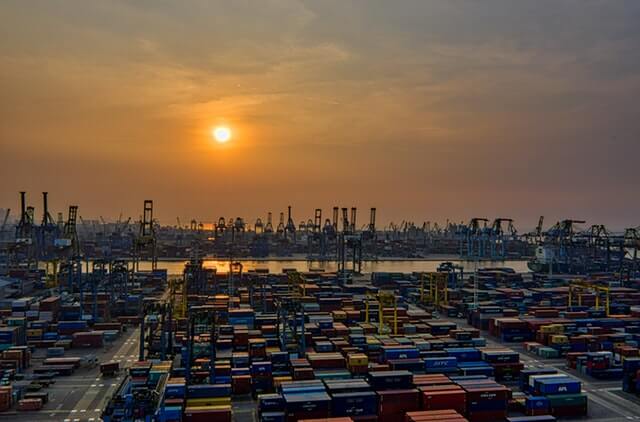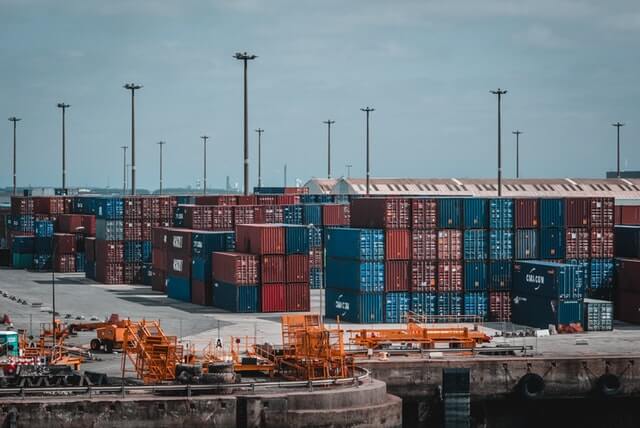Drayage is the short-distance transportation via ground freight and/or the correlating charge for such. The origin of the word “drayage” is “dray”, which was historically defined as a cart (pulled by horse carriage in former times). Now it refers to a cart, without fixed sides, used for carrying heavy loads for only short distances. Drayage is a critical aspect of the transfer of shipping containers to and from other means of transportation.
The dictionary defines drayage as the ‘act of transporting goods over a short distance’. Furthermore, when used in the shipping industry, it more specifically refers to the intermodal transport of shipping containers from, for example, port to port or port to railyard.
In freight forwarding, drayage is typically used to describe the trucking service from an ocean port to a rail ramp, warehouse, or other destination. Focusing on port drayage, the term for describing short hauls from ports to nearby locations, this is where our discussion begins.
Classifying Drayage
There are many of classifications of drayage services and which one you select depends on your shipping needs. The following classifications come from the Intermodal Association of North America:
- Expedited drayage: speedy transport of shipping containers. Best for time-sensitive shipments.
- Inter-carrier drayage: This standard concept of drayage. It is the movement of goods between different carriers. For example, inter-carrier drayage could involve transporting goods from a trucking terminal to a rail station.
- Intra-carrier drayage: this is when containers are taken to two different hubs that are owned by the same carrier. Cargo may be transported from an intermodal hub to a rail hub.
- Pier drayage: this is for containers needing to go from a rail terminal to an ocean shipping dock or pier and uses highways to do so.
- Shuttle drayage: This involves moving an intermodal unit to a temporary stopping point, especially when the hub of origin is overcrowded.
- Door-to-door: Container delivery by truck to retail customer
Drayage Charges
Drayage charges are odd in the sense that during the quoting process, not all charges are known or quoted upfront. When sending out RFQ’s its important to get as many possible charges on the quote as possible- in order to avoid surprises on the invoice.
Most charges are known or can be estimated beforehand.
Most commonly known drayage charges include:
- line haul rates
- fuel surcharges
- charges specific to the pick-up/drop-off terminal
- chassisWhat is a chassis? Chassis, in freight & logistics, refers to a skeleton framework with wheels on it used to move containers. It is also called intermodal chassis or container chassis. Similar to ... More positioning, return and rental
- tolls
- refrigerated, bonded, overweight, hazardous, etc.
- Congestion fees (wait time at busy ports)
Drayage charges which are typically unknown at the time of quotation are demurrage and detention charges. There can be other delivery-specific charges as well.
It is important to ask the right questions to drayage companies, including freight forwarders and ocean carriers, when collecting quotes. In order to get an accurate cost prediction upfront, the more of these charges that are referenced, the better. Only when all the known charges are listed on all quotations, can you really compare the providers.

A little background into today’s drayage discussion…
It’s not breaking news that due to increasing container ship sizes, seaports face difficulty in handling such capacity. High volumes in landside container handling are directly linked to the ongoing growth of container ship sizes and thus create high traffic on the port street network. What is newsworthy however, are the latest demands that the government, environmental organizations and local residents are imposing on port companies regarding environmental and social concerns.
The demand for improving the port’s ecological footprint, calls for the reduction of truck congestion at container terminals. Port drayage often accounts for a high percentage of the overall transportation cost and for a large proportion of truck arrivals at container terminals. And unfortunately, the pricing scheme for drayage is chaotic like much of the other fragments of the industry. According to Charles W. Clowdis Jr. of HIS Economics, “There’s no rhyme or reason to it. It is a pure whatever-the-market-will-bear pricing scheme. What somebody pays can depend on the day of the week and the time of day.”
Additionally, the upsurge in fuel costs don’t allow for many cost-cutting options along the supply chain. Drayage, in terms of both time and distance, is a small part of the supply chain- yet it can contribute excessively high costs and potential problems.
What’s the issue?
By regulating dray activities, environmentalists have sought to reduce trucking pollution in ports. Businesses became more aware of the costs of port congestion and regulations on driver hours of service, as the congestion charges and fuel costs increased. Public safety advocates have been concerned with the impact dray trucks have on city streets. Using these streets during normal working hours, they have been labelled as “under-regulated and a risk to commuters”. Lastly, organized labor in the US have called out the trucking industry on the use of “low bid carriers”, referring to the unfair bargaining power the industry has over a glut of independent contractors.

Some structural insight
The independent contractor employment situation in the US is what is currently causing the biggest buzz. It is not the same structure in Europe. Hungary, Slovenia and Malta represent the largest proportion of self-employed truck drivers in the European Union. However, this proportion is still not larger than 15% for either of these countries in stark contrast to the 86% in the US .
The US drayage industry relies on owner-operators/independent contractor to move freight, so legal actions against this model in the states of California and New Jersey could pose a problem. They could, in effect, restrict the number of owner-operators available to work and consequently disrupt drayage operations.
Within many industries, the independent contractor business model is prominent and legally in existence. Often times this model is used inappropriately, however. Employers will categorize workers as independent contractors to avoid paying retirement and medical benefits, unemployment compensation, and other state and federal taxes. In an effort to recover this lost revenue, governments are investigating the independent contractor model more and more.
In 2018, the California Supreme Court’s ruling in the case of Dynamex Operations West v. Superior Court was codified in law as Assembly Bill 5. Under this stipulation, employers must use the “ABC test” to prove workers are truly independent contractors.
The ABC test is comprised of 3 prongs which are as follows:
- Prong A: the worker is free from the control and direction of the hiring entity,
- Prong B: that the work performed is outside the usual course of the company’s business, and
- Prong C: the worker is engaged in an independently established trade or occupation.
To qualify as independent contract status requires that all 3 of these prongs are fulfilled. Prong B is expected to be the most difficult requirement to satisfy for drayage companies because they are engaged in trucking during normal trucking hours. Conversely, prong A is expected to be the easiest to prove- as the owner-operators own and drive the trucks, they are free to decline loads booked by the drayage companies, which shows that the companies do not exert direct command over the drivers.
The California Senate has recently passed the AB5, which if approved by the governor, will go into effect January 1st, 2020. The bill calls for a reduction in what it has been referred to as “widespread misclassification of independent contractors”. Unfortunately, the outcome of this bill will shake up business in the US, as the two largest container terminals in the US are located in California. Furthermore, the spread of this idea on to the state of New Jersey is causing panic as well. Massive changes are likely to hit 3 out of the top 5 container terminals on both sides of the country.

What is the opposition saying?
“In the current business model, we need that independent owner-operator to exist,” said David Hensal, CEO of Eagle Systems, an intermodal drayage provider based in Caldwell, N.J. “I think if we don’t solve this problem, we’ll only be able to operate in those states that allow the owner-operator model. I think you’ll see cargo flows move out of ports that aren’t friendly.”
Many drivers became owner-operators because they wanted to earn their own income and have flexibility over where and when they work according to Joe Rajkovacz, director of governmental affairs and communications for the Western States Trucking Association. “If you take that away and tell me it is a W-2 and forced dispatch, there are a lot of people who say, ‘I’m done.’ This is going to cause some of the most experienced owner-operators and drivers in the industry to just say, ‘See ya.’ ” A W-2 is a government employment form used for tax purposes issued to full-time and part-time employees, not inclusive of self-employed individuals.
Yeni Hercules, CEO of H&P Logistics (based in California) said of owner-operators: “They bought a truck and started a business,” she said. “They want flexibility, and they want to work when they want to.” With nearly 40% of their trucking done by owner-operators, Hercules has asserted that disinterest in working at the port could cause a lack of supply at the port and would take time to replenish their force.
For now, the future is hanging on the final decision on whether this bill goes into effect or not. Should it happen, anyone shipping in and out of the US can expect higher charges, time delays and restructuring- perhaps truckers incorporate themselves or operations move to less restrictive states. Port authorities in the US Southeast have already opened inland ports in recent years to reduce long drays, alleviate truck capacity, and increase driver productivity. We could see more and more movement towards inland ports in the future. And while you can’t necessarily do anything against increasing drayage costs, you can reduce demurrage and detention by using SOC containers.




